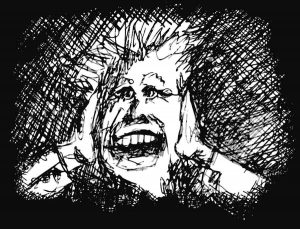Written by Valentina Dragomir, Psychotherapist |

In this article we turn our attention to a few patterns of thinking that affect us every single day. They are called cognitive distortions and have an important role and impact in our lives.
But before I start talking about them, I’d like to share something that a client said during therapy.
“This week hasn’t been too good. I start to see things differently again, to think that nothing goes well, that what I do makes no sense. I only have negative thoughts, I get stuck in them, I can’t focus on anything else.”
The person who said these things was depressed. And these negative thoughts prolonged the depression state.
Because our thoughts are responsible for the emotions we feel, we can change how we feel if we change our thoughts.
This is why it is important to talk about these patterns of thinking.
Below I will tell you about how they work, what they are, where they come from, what their role is, what their effects are, how many types there are (and examples) and what strategies we have to change them and how to maintain the changes.
All this to help you understand why you have these types of thoughts and get the necessary tools to change them yourself, in the comfort of your home.
What are cognitive distortions?
We all see and relate to the world through our own lens. This lens is influenced by one’s beliefs, culture or personal experiences. Therefore, we can interpret reality with more or less accuracy, sometimes even distort it. When that happens, our mind runs thinking patterns that are called cognitive distortions.
The term cognitive distortions comes from cognitive theory and therapy. They are called this way because they show us distorted ways of thinking about oneself, the world and others.
These specific patterns of thinking are common to all of us and we run them in our mind automatically without realizing we do it.
Cognitive distortions are identifiable patterns of thought. They have no real foundation and trigger negative emotions.
What are the causes or sources of cognitive distortions?
Cognitive distortions do not have a single cause. They are part of the individual’s system (culture, family, life experiences). Although it is not very easy to identify every possible cause, we can name a few causes that can lead to cognitive distortions.
Personal experiences and the meanings we assign to them
Each person assigns subjective meanings to the experiences they went through. One same experience can be lived differently by two different people, and can affect people differently.
The meanings or conclusions that we attribute to these experiences relate to what we already learned, or may be new beliefs, rules or labels.
For example, we were humiliated in front of others in the past and people laughed at us. Being an experience with a strong emotional impact, its effects can make us think that others will always laugh at us in the future. Believing this has an impact on how we behave around people or in specific situations.
Strong emotions (anger, fear) and stress

Fear and anger are two basic emotions that can influence our perception. They are related to survival and can lead to the creation of deformed beliefs about the world, us, others, life.
The stress and pressure of time can influence how we perceive things. If someone is pressing us to form an opinion of something or if we rely on what we feel or think at first sight, surely what we think can be crowned with cognitive distortions.
The faster you draw conclusions about people, things or situations, the higher is the chance that they are wrong.
If the people who are present in the social or family circle of an individual have distorted ways of thinking, they can pass the cognitive distortions to the individual.
As children we pay special attention to the people who are important for us and we learn from them without filtering (judging or evaluating) what we learn. And we can learn cognitive distortions and think that it is normal to see things that way.
The things we take over from our family or authority figures can change over time, when we begin to form our own filter.
The culture of the individual
Misconceptions about the world, others, life in general, contain plenty of cognitive distortions. These can be learned, inherited or promoted in the culture of the individual.
Often these preconceived ideas can be changed if the person makes contact with other cultures and learns that things can be different in other cultures.
For example, many preconceived ideas contain cognitive distortions such as overgeneralization, dichotomous thinking, labeling.
All …. are …../ Women who …. are ….. / Men who …. are …. / Boys (don’t) do …../ Nice girls (don’t) do …. Politicians are ….
Other examples of cultural cognitive distortions are racism, sexism, homophobia, xenophobia, antisemitism, anti-Romanism, misogyny, misandry, anti-gypsyism, anti-Christianity, all of which can contain multiple cognitive distortions related to other cultures or certain people, without any evidence or cause.
Other cognitive distortions
One cognitive distortion doesn’t come alone. It can come with its family, or it can birth another, creating a system of distorted beliefs around a single subject.
This process is like a downward spiral in which the scenarios in our mind are getting worse, more catastrophic, with each thought. The effects are that the emotional and psychological levels (sometimes the physiological level) are directly and profoundly affected.
The more we go into detail with these thoughts, the higher are the chances to lose ourselves in them.
What are the functions of cognitive distortions?
In other words, why do we have these types of thoughts and what do they do for us?
They help us survive
Evolutionary psychology suggests that cognitive distortions are natural consequences of human vulnerability to hazards.
Humans have evolved to think adaptively rather than logically. When they adapted they protected themselves from dangerous situations and survived.
The guiding principle behind cognitive distortions is “better safe than sorry”.
This is why we avoid traveling by subway if we anticipate (as in imagining) that we will get sick or get stuck in it. Or, another example is that we don’t allow ourselves to make mistakes if we think that others will think we are incompetent. Better safe than sorry. But is this really good for us?
The situations above, traveling by subway or making a mistake, are not situations that endanger our lives. However, the thoughts we have about them (how we perceive them or what we imagine will happen) activate the same alarm circuits in the brain as when our life is threatened.
Currently, humans are no longer facing predators that can endanger their lives. But this is only from a couple thousands of years compared to millions of years of evolution, adaptation and survival. This is why our brains’ alarm systems didn’t change.
Therefore, if we have cognitive distortions that are not useful to us today, it does not mean that we are irrational or that something is wrong with us. They function on the mechanisms in the brain that are related to survival.
What are the effects of cognitive distortions?
Cognitive distortions have a negative influence on our emotional state
The thoughts we have influence our emotional state.
Depending on the thoughts we have, we can feel positive or negative emotions. Thus, negative thoughts or cognitive distortions, can determine us to feel negative emotions.

It is absurd to think that we can feel happiness if we have catastrophic thoughts such as losing our job and becoming homeless.
Cognitive distortions encourage maladaptive behaviors
In cognitive behavioral therapy (or CBT) we have an event (internal or external) that we call trigger. This trigger produces a thought, which in turn produces an emotion. And as we learned about emotions, they set us in motion and can determine us to do certain actions.
These actions (behaviors) can often be disruptive. That is, they can have negative consequences on a personal, relational, social and psychological level.
And to make this model more clear, I want to give you an example below.
In short, we have the following model:
trigger → thought → emotion → behavior
Transposed in real life, this model can be exemplified as follows:
At work I receive feedback or criticism (trigger).
The thought I may have, for example, is that I am a weak employee.
The emotion I feel is shame.
The behavior I have is to skip work for a few days or to hide, avoid contact with the person who gave me the feedback / criticism.
This behavior has negative consequences for me, as I can be penalized for the days I am skipping work. It can negatively affect the relationship with that person as well. Moreover, my behavior can strengthen the belief that I am a weak employee, because I am avoiding going to work.
Psychologically there are consequences too. For example, my self-esteem is dropping. This can lead to other negative thoughts about myself, other cognitive distortions, negative emotions and maladaptive behaviors. Hence the downward spiral I was talking about earlier.
Cognitive distortions increase the chances of developing and maintaining depression and anxiety
Many cases of depression and anxiety are due to a thinking pattern populated by cognitive distortions.

Having constant negative thoughts can affect us so deeply that it can change our emotional state, leaving room for the installation of depression and anxiety.
If the thoughts are not balanced during psychotherapy, cognitive distortions can maintain the symptoms of depression and anxiety. Thus the negative vision of ourselves, the world and others may persist for a longer time. Also, the physiological symptoms of these disorders can persist over time as well.
How many types of cognitive distortions are there?
There are several types of cognitive distortions. If we know what the types are, we can identify the patterns more easily. The purpose of their identification is to be able to change them, a process usually called balanced thinking.
Balancing or changing our thinking affects the emotional state in a positive way and can be an emotion management strategy. We can change the present emotions and the emotional state.
Below are some of the main types of cognitive distortions identified by Aaron Beck, the most important figure of cognitive psychotherapy:
Dichotomous thinking
This pattern of thinking is also called black and white thinking (sometimes all or nothing). Black and white thinking leaves no room for grey areas. Things are good or bad, right or wrong, you are correct or incorrect, you are successful or you have failed.
This type of thinking only highlights an extreme pole of a situation. Any deviation from perfection is painful and a catastrophe.
Examples:
- He/she didn’t respond to me as I wished. He/she doesn’t love me.
- I forgot to go to the gym yesterday (one day, although I went to the gym 5 days in a row). What a failure.
- If I’m not the best at everything I do, I’m completely useless.
Over-generalization
Over-generalization is the pattern of thinking through which we draw general conclusions on past experience. We make deductions about the others, the world, us, based on a single event (or one or two experiences).
Over-generalizations can include words like “always”, “all the time”, “never”, “all …”.
Examples:
- My partner cheated on me. (All) Women / (All) Men are cheaters.
- I was rejected at the interview. I will never find a job!
- A bee stung me when I was 13 years old. (All) Insects are dangerous.
Mental filter
The mental filter is called this way because we focus only on the negative aspect of one thing or event, despite other positive evidence.
We can also filter the things we remember, looking at the aspects we want to see. Often the aspects we tend to look at are negative, although there are positive aspects too.
Examples:
- A person can focus on the fact that someone told him that his shirt looks bad, although others complimented the same shirt. Therefore, the shirt is ugly.
- The presentation was not good, so said the boss (although the boss included in his feedback aspects that were good in the presentation, and mentioned only one aspect that can be improved for next time).
- The conversation was unpleasant because we had different opinions on one aspect. (although the rest of the conversation was stimulating and interesting).
Catastrophizing or maximizing
Catastrophizing or maximizing is a pattern of thinking through which we imagine that the worst possible scenario will happen.
Sometimes this cognitive distortion starts with “what if …”.
Examples:
- We have catastrophic thinking when we say something wrong in an interview and imagine as consequences that we will not take the interview, we will not get the job, we will not have money to pay or bills and we will end up on the streets.
- What if I don’t get the job? I will end up homeless.
- I have pain in my lungs. What if I have cancer and will I die?
- What if he leaves me because I didn’t send him a message today? I will be single and not be able to find another partner.
Jumping to conclusions (1): Thought reading
This cognitive distortion refers to our “ability” to read what another person is thinking, usually about us, or what his intentions are.
Examples:
- If I postpone our meeting, my friend will think I’m not serious.
- He thinks I’m a loser because I insist.
- He doesn’t want to hang out with me. He thinks I am boring.
Jumping to conclusions (2): Fortune telling
This distortion in thinking refers to our “ability” to predict the future, although we do not have enough data.
Examples:
- He promised me we would go to the theater, but he will be busy that day and will cancel.
- He doesn’t care about how I feel. He will forget what I asked him yesterday.
- I already see that he will embarrass me at the party.
Labeling
Labeling is one of the cognitive distortions by which we label ourselves and others negatively, based on a specific behavior or action.
Examples:
- How stupid I am because I dropped my bottle of water.
- She’s careless. Yesterday it was my birthday and she didn’t care to send me a message.
- He is envious because he did not congratulate me on the promotion I received.
Personalization
Personalization is a cognitive distortion by which we take the blame for what happens, without having a logical reason for it.
Our interpretation is that negative events happen because of what we did or didn’t do.
Examples:
- My partner didn’t talk to me today. Of course I did something that upset him. (when in fact my partner was busy with his job)
- My child got a low grade on a test. It’s my fault (the parent) for his low grade. I should have made him learn more.
- I’m guilty that my mother is upset. I should have done more for her.
Emotional reasoning
Through emotional reasoning we give meaning to something according to what / how we feel. This means that we take our feelings as proof that something is wrong or dangerous. What we feel is the only evidence we have.
Examples:
- I’m afraid of the plane, so planes are dangerous.
- I have anxiety, therefore something bad is about to happen.
- I get bored when I watch the movie, so the movie is bad.
Disqualifying the positive or minimization
Disqualifying the positive is a cognitive distortion by which we don’t take into account some positive aspects by minimizing them.
Examples:
- When someone gives us a compliment we can think something like: “He just says this to be polite”
- When someone admires our efforts we can say this: “Big deal! I didn’t do that well. It was easy, anyone could do it”
- When someone gives us a positive feedback we can respond like this: “I don’t deserve your nice words, it just happened.” Or “I don’t know what happened or why my presentation was so good, the planets aligned for me today.”
Shoulds and musts
Shoulds and musts show a pattern of thinking that betray certain strict internal rules about the world and others. Life has to happen in the way that person expects. Or according to his rules.
Such thoughts put pressure on both the person who has them and the other people.
These cognitive distortions are the easiest to identify because they contain the words “should” and “must”.
Now it’s important to not take all the “must” or “should” statements as cognitive distortions. For example “I must finish the project before the deadline” is not a cognitive distortion.
It is normal to think so when you are planning your time. However, problems arise when we think as in the following examples:
- I should/must never upset my spouse.
- A man should/must always bring flowers to his lover, otherwise he does not love them.
- A woman should/must never deny anything to her partner and always forgive them.
- I should/must always please the other people.
How can you change the cognitive distortions?
Cognitive distortions are automatic thoughts and it can be difficult to realize they are present in our mind. But awareness is a key step here. After you learned to notice your thoughts and identify (label) the cognitive distortions, the next step is their confrontation.
Confronting cognitive distortions is a very important step in balancing our thinking. And as I wrote earlier in the article, if we change our thinking, we change our emotional state. As a result, we feel better.
If you think in a balanced way, your emotional state is balanced and your actions are appropriate.
So, here are some steps to change negative thinking:
Step 1: Keep a journal
If we don’t notice what is going on in our mind, we cannot begin a process of change. Looking at the examples of cognitive distortions above, I suggest you try an exercise.

The exercise is as follows: every day for 40 days, write down on a sheet of paper 5 cognitive distortions and label them. It is very useful if you have a journal where you can keep your notes together.
A while ago I also went through the same process of awareness and identification of cognitive distortions. It was a bit difficult at first. But with examples I was able to identify my cognitive distortions more easily.
Step 2: Check reality
With a few simple questions you can check if what you think is actually true. Here are some examples of questions you can ask yourself, some of which may be similar to others:
- Why do I think this?
- Why would this thought be true?
- Do I have proof for my thought?
- Is my thought justified?
- What would be another way to look at this situation?
- Did I go through this in the past? How did I manage then?
Step 3: Ask the opinion of a person you trust
If you feel you are going down the spiral of thoughts, ask the opinion of a close person you trust.

What does this person think? What is his vision? Is it different from yours? If so, what are his reasons?
Step 4: Rewrite the thought in a balanced form
The questions above probably helped you to check the reality and to notice that your thoughts don’t have roots in reality. Now you can rewrite the thought in the journal in a balanced manner.
Step 5: Notice if your emotional state changes
When I work with people on changing the distorted patterns of thinking, they may feel immediately a change in their emotional state. This change is the result of balancing their negative thoughts.
Evaluate your emotional state when you have the thought and after changing the thought. Notice if you feel different after changing a cognitive distortion.

If we process cognitive distortions every time we notice them, we can create different patterns of thinking. We can create and maintain a balanced thinking.
With balanced thinking, we have balanced emotions and behaviors.
Advice for balanced thinking
You went through the steps above and changed some of your cognitive distortions. Well done!
What’s next now?
Maintenance
As with losing (or gaining) weight for balancing it, maintaining weight helps us keep our weight in a healthy place for a long time.
Maintenance is a process that involves several actions, some of them can become new habits. If we go back to the same habits, we will actually return from where we left off.
I believe it is the same with thinking. It may not help to change one thought once. We need to be persistent in order to maintain a balanced type of thinking.
In addition to being persistent, here’s other tips for you to keep your thinking balanced.
Meditate
Meditation is one of the best habits we can bring in our lives.
Meditation is of several kinds. For example, there are guided meditations based on breathing, guided imagery and mindfulness.
Want to try mindfulness meditation? Make yourself a nice cup of tea and then click this link.

Meditation has many benefits and science was busy demonstrating this for decades. Meditation reduces stress, promotes well-being, helps balance emotional state, helps connect with oneself, sharpens our attention and focus. These are just some of the benefits of meditation.
Personally, I use a meditation platform that I recommend to everyone. It’s called Headspace. You can also find the app you can download on your phone to make headspace meditation more accessible. It is excellent!
There are other applications that I heard are very good, but I did not test them: Calm and Meditopia. I heard good opinions about them.
Try them if you want. Maybe you can find other meditation apps that suit you better. All that matters is that you start.
Write in your journal
I believe in the power of writing in your journal. It is an excellent tool to balance our thinking, take stuff off our chest and keep track of what’s going on in our minds.
Use adequate words when you speak to yourself
Didn’t we somehow start with the things that we say to ourselves? The inner monologue? What we say reflects what we think.
The words we use have a direct impact on us, even if we are aware of it or not.
If we use words that help us see ourselves in a good light, our emotional and mental states will be good. If we criticize and label ourselves harshly, the result will be negative.
When all this is not enough …
Go to see a psychologist.
If you tried the steps above and they were not enough for you to feel any change, you may need the guidance and support of a specialist.
Remember that it is possible to make changes in the patterns of thinking. A psychologist is the right specialist to help you do that.
Working with a psychologist you can get help to understand what are the roots of the emotions you feel. You may discover how your history has influenced your perception on some aspects of yourself, others or life. And you can start taking the steps you need for a change, in individual therapy.
How do you keep your mind free of cognitive distortions?
A summary
- Cognitive distortions are common distorted ways of thinking about oneself, the world and others that run in our minds automatically.
- There are many types of easily identifyable cognitive distortions, the most common ones are: dichotomous thinking, over-generalization, mental filter, catastrophyzing, thought reading, fortune telling, labeling, personalization, emotional reasoning, disqualifying the positive and shoulds and musts.
- The cognitive distortions most often present the reality in a negative light and that triggers anxiety as a response.
- There are many ways you can deal with these cognitive distortions. These ways are psychotherapy, or you can keep a journal to track these cognitive distortions and modify them, checking reality and asking the opinion of a person you trust.
- If you feel nothing you tried works, then see a psychologist/psychotherapist.
References
- Cognitive Distortions, Humor Styles, and Depression, Katerina Rnic, David J. A. Dozois, and Rod A. Martina, Eur J Psychol. 2016 Aug; 12(3): 348–362, doi: 10.5964/ejop.v12i3.1118
- Burns, D. D., Shaw, B. F., & Croker, W. (1987). Thinking styles and coping strategies of depressed women: An empirical investigation. Behaviour Research and Therapy 25, 223-225. doi:10.1016/0005-7967(87)90049-0
- Aaron T. Beck Psychopathology Research Center. (n.d.). Aaron T. Beck, M.D. Aaron Beck Center. https://aaronbeckcenter.org/beck/
- Beck, Aaron T. (1972). Depression; Causes and Treatment. Philadelphia: University of Pennsylvania Press
- Burns, David D. (1980). Feeling Good: The New Mood Therapy. New York: Morrow.



